__________________________________________________________
"Flight of the Thunderbird Sky Dreamer"
________________________________________________________________
Bimisen Dibishkoo Migizi
Binesiiwin
Binesi izhinamowinan waasa izhaamigadon.
“Fly Like an Eagle
Be like a Thunderbird
Thunderbird dreams go far.’’
________________________________________________________________
Boozhoo, biindigen!
Today, I am pleased to present
part 31 of a blog series connecting my jewelry and
graphic art as well as artwork by kindred artists with the Seven
Grandfather teachings of the Ojibwe Anishinaabe
People.
These Grandfather Teachings,
kept safe for thousands of years by countless generations of Medicine People of the
Anishinaabe Peoples, are passed down orally and from the sacred birch bark
scrolls that still exist today.
Today’s blog story is woven around two images of canvases by the late
Miskwaabik Animikii (Norval Morrisseau) as well as a Thunderbird feather ring
set and three illustrations (digitized pen and ink on paper drawing) of my own making. The illustration shown above, titled "Spirit Flight," is presented
here as a special tribute to a friend of mine who is originally from Manitoba.
My friend’s traditional name is Makade Migizi, or Black Eagle; his
clan is Binesi (Thunderbird). He is i.a. a musician, a traditional dancer, and someone who seeks knowledge in the Medicine Lodge; in short a man
of many gifts and talents. He recently told me a touching story about his
teacher, a road man in the Midewiwin Initiation Lodge who recently crossed over
to the spirit world. This Anishinaabe Elder from Ontario was a remarkable man;
besides being my friend’s spiritual guide he was many things to many people. A
father and a grandfather, a teacher and a name-giver, a sun dancer and a rain
dancer, a water drum carrier and pipe carrier and eagle staff carrier, and much
more. To my mourning Manitoba friend, and the remarkable story that he shared
with me about his recent loss, I dedicate the pen and ink drawing titled
“Spirit Flight.”
Feathers of the Bald & Golden Eagle
To start off let’s first take
a look at the eagle feather; after all, it is the eagle feather that is the
most sacred of objects to our People, and it is the eagle feather that gave
this series its name.
Anishinaabe tradition tells us that an eagle feather is manidoo – a spirit. Carrying an eagle feather is a sacred act and it comes along with great responsibilities since it is believed the power of a feather comes directly from Binesiwag, the Thunderbirds; a person who is worthy of bearing an eagle feather must therefore acknowledge that he or she is recognized by Animikiig, the Thunder Grandfathers themselves, as being able to use their formidable spirit powers. To be given a feather of a bald eagle or golden eagle is therefore one of the greatest honors to receive, because it recognizes achievement and great acts or deeds.
__________________________________________________________
 |
| “The First Feather,’’ pen and ink on paper by Zhaawano Giizhik ©2013 Zhaawano Giizhik |
__________________________________________________________
Migizi, the Bald Eagle
“In a sacred way I hold this feather.
Because of all the creatures
you reach the highest out
in bringing pure vision to those who seek it,
your feather will not only be a living prayer,
it shall symbolize human life itself.
The quill symbolizes the life path.
Each strand stands for a lesson.
Whoever will hold this feather
Will speak honestly from his heart.
Like life itself, your feather is sacred.”
(Words spoken by GICHI-MANIDOO (The Great Mystery) as it offered Migizi's feather to the Anishinaabeg. Migizi thus became symbol to the People of prayers being carried high.)
______________________________________________________________
Migizi, the
Bald Eagle, symbolizes in our culture virtues like courage and pre-knowledge
and is therefore emblematic of leadership. The Anishinaabeg regard Migizi as
gimishoomisinaan, our Grandfather, and a special messenger of GICHI-MANIDOO,
the Supreme Spirit Being of the Universe. His sacred feathers, which are
animated by his vision, strength, and courage, have always been used as
offerings and as decorations for ceremonial costumes and regalia. To be given
an Eagle feather - or to be named after him, like my friend from Manitoba - is one of the greatest honors to receive because
it recognizes achievement and great acts or deeds.
According to
Anishinaabe tradition, Gimishoomisinaan Migizi was a long time ago chosen by
GICHI-MANIDOO (the Great Mystery) to represent the Teaching of Zaagi’idiwin
(Love).
The reason
for this is that Migizi flies high above the earth and sees all that is true.
Since he is closer to GICHI-MANIDOO than any other creature he was touched and
even infused by GICHI-MANIDOO's love for all creatures. Our ancestors also
understood that Love is the most elusive of all virtues...no other creature is
so elusive as this mighty spirit-bird, and love has the same light and airy
nature as his feathers...
Giniw, the War Eagle
Catching the darkness up
I hear the eagle bird
Pulling the blanket back
From the East, sleeping still
How swift he flies,
Bearing the Sun to the morning
See how he perches there
In the trail of the Eastern sky."
Gimishoomisinaan Giniw, the Golden (or War) Eagle Grandfather with the black head, is one of the taloned bird species of the natural world that in particular represent the supernatural powers of the Thunder Grandfathers. Where Gekek is mizhinawe (messenger) for the Thunderbird, Giniw is his oshkaabewis (ceremonial attendant or helper), and, as thus, an important medium or interpretor for the various Thunder Lodges of the Ojibweg. Wiindigookaanan, or Contraries – a special category of people who have gained some of the medicine, or power, of the animikiig, the Thunder Grandfathers – regard Giniw as their ogimaa (chief). Giniwag are also known to land on trees struck by lightning. Giniw has always been assiociated with ishkode (fire). Since giniwag collect static electricity in their wing feathers, a person might be able to start a fire from his feathers. This is how the original ishkode was made for the madoodiswan, or sweat lodge; it was Thunder who started the fire for it!
Known as the protector of Ziigwan, the Spring Grandfather who also lives in the East and as the one who watches over all women – particularly those who are in new beginnings –, Giniw is regarded as antipode of the almighty Migizi (bald eagle).
Why is Giniw called so? At first sight it would appear giniw resembles the sound that they make. Their occasional calls tend to be high, weak, and whistled. You’re most likely to hear these winged relatives during breeding season, when nestlings’ high-pitched begging calls can reach far. However, it seems more likely that the name describes the bird's talons. It has the same base as giniw in oginiiwaatig (rose bush), which is describing the pointy thorns. Anishinaabemowin, our language, is a verb-based language, so the description may well have been used as an identifier. So, in a linguistic context, it should be pointed out that giniw, instead of being a proper noun, is originally a verb that describes the bird's physical attributes.
__________________________________________________________
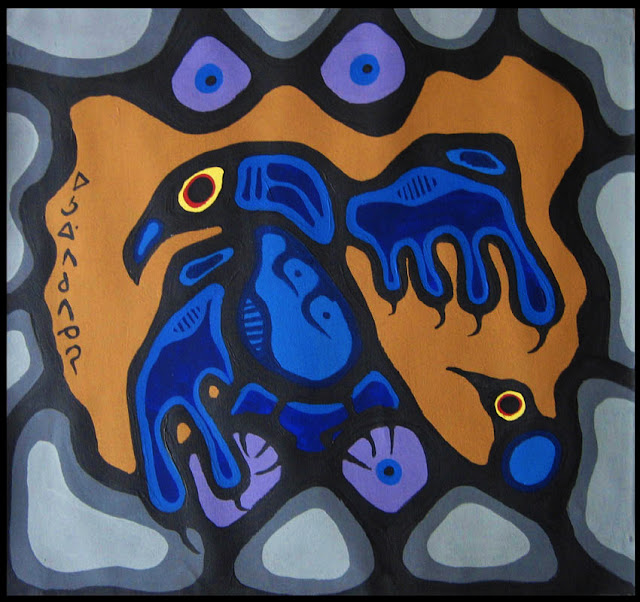 |
| “Thunderbird in a Place of Power,’’ acrylic on canvas by the late Miskwaabik Animikii |
Who are the Thunderbirds?
According to
Anishinaabe tradition, the Thunder Grandfathers came to earth in the beginning
of times to govern the quality of man’s existence, and that of the animals and
plants, with supernatural powers over which the Anishinaabeg had little or no
control. Thunders became thus associated with fertility, and with the creation
of clouds and rain. The Thunders are often perceived as gigantic birds, called
Animikii Binesiwag: Thunderbirds.
Large taloned birds of prey, such as the giniwag (golden eagles), are thought to nest on high cliffs, particularly those situated along waterways. The large white streaks that can be observed on certain rocks and cliff walls would be, for our ancestors, the birds' droppings, and would therefore be a sign of the living locations of the Thunderbirds. It is assumed that large concentrations of ashkaakamigokwe mashkawiziiwinan, mother earth's energies, can be found on top of those high rock cliffs. The binesiwag that nest there were believed to disperse these sacred energies into wendaanimag noodinoon, the four winds (cardinal points), with which they therefore had a special relationship.
This is why, to the Anishinaabeg, the Animikii Binesiwag as well as their natural counterparts, the golden eagle, the bald eagle, and the hawk, are mizhinaweg (messengers) that mediate aki's sacred energies between nimaamaa-aki (the earth) and ishpiming (the sky). As such, they are believed to be essential links between the spirit and physical world. And for the same exact reason our ancestors never neglected to offer asemaa (the sacred tobacco) when they saw a bird of prey flying overhead or in places where the Thunderbirds are thought to reside - or when a storm, caused by these winged Grandfathers - was approaching.
The eye of the Thunderbird
Binesiwag, the Thunderbirds, are said to be related to the wendaanimag noodinoon, the Winds that blow from the four corners of the Earth. Animikiig, the Thunderers, are considered the most pervasive and powerful beings of all the Aadizookaanag - Spirit Grandfathers - that guard the four cardinal points of the Universe. They leave their homes on high cliffs and mountain peaks in the west in the beginning of spring and come to Earth in different forms and guises and sizes - as winged beings, or sometimes even in human form - to visit the Anishinaabeg and to drive off malevolent underground spirits from the Earth and the waters of lakes and rivers. They are in charge of the warm weather and procure and maintain the warm seasons on Earth, which is why they migrate with the birds that appear in spring and disappear in the fall. Their thunderclaps herald the presence of powerful manidoog or Spirit Beings, their lightning arrows carry strong Medicine.
It is said that the eyes of the Thunderbird Grandfathers, who
have a close and beneficial relationship with humans and are known to impart
knowledge and foretell the future, are able to see and explore the hearts of
human beings and discern their skills, talents, and desires. This brings up memories
of a long time ago when the Anishinaabeg still wandered aimlessly on the face
of Aki (Earth), disheartened and disorganized and standing on the brink of
extinction; it was then that Grandfather Binesi was sent to Earth to aid the
People in finding their place in the world and in making them aware of their
collective and individual skills and talents needed for developing self-worth
and for survival in a harsh and hostile environment. Thunderbird also taught
the Anishinaabeg to organize themselves in odoodemag (clans), thus shaping the
bedrock of a strong society.
Spirit Flight and Thunderbird Visions
__________________________________________________________
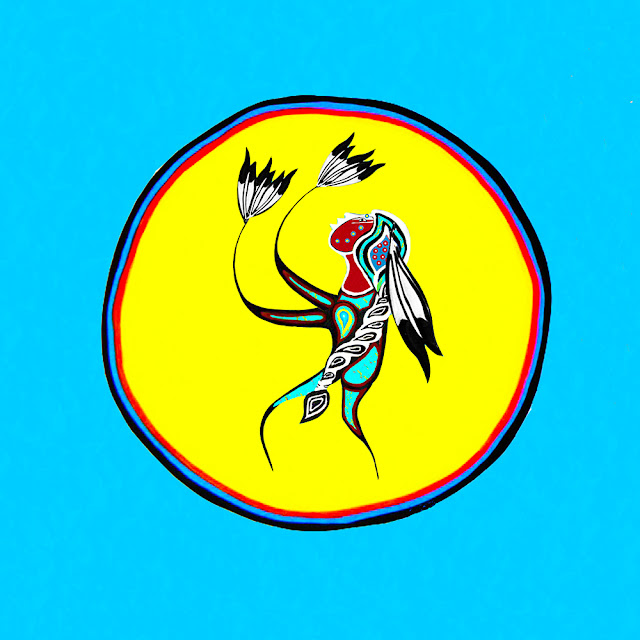 |
| “Vision Quest,’’ digitized pen and ink on paper by Zhaawano Giizhik ©2022 Zhaawano Giizhik |
__________________________________________________________
Today's story is essentially about a phenomenon that we will call ojichaag bimisewin or “Looking Beyond’’ (literally:“Spirit Flight’’).
Looking Beyond, that spiritual journey into an unknown and unseen world that lies beyond ratio, time, and space, is a special and often elusive dimension in our existence, and in the old days the Anishinaabeg used to put it into practice through a variety of ritual means. One of these means was the ceremony of GIIZHIG-INAABANDAMOWIN or ‘‘sky dreaming.’’
In the old days, Anishinaabeg weshkiniigijig (youth of both genders) used to seek a life-guiding dream by undergoing a ritual complex called makadekewin, or “Vision Quest.” They received preparatory instructions for the makadekewin from their grandparents or trusted community Elders. Final preparation required gii'igwishimowin, or spiritual fasting, which typically lasted eight days.
The waaseyaabindamowin, or dream-vision (literally: "being in a state of being light, or clear") was usually sought after in remote, mystic spots where there was a large density of spiritual presence. Isolated fasting and plaintive contemplation, usually for four days and nights, were necessary to reach such a state of spiritual enlightenment which, once realized, ideally provided for guidance for life. In times of confusion, stress, or trouble, the owner of a waaseyaabindamowin could reflect on the most minute elements of the dream-vision and at the same time upon its broadest cosmological symbolism. The waaseyaabindamowin was usually of a bawaagan: a guardian spirit in the form of an animal or a bird. The subject of the waaseyaabindamowin could be a Thunderbird, or an awe- inspiring thing or phenomena - such as Fog, Hail, the Northern Lights, Thunder, Lightning, Rainbows, the Morning Star - or an animal - such as an eagle, a hawk, or a bear -, or the bank-dwelling water spirits called Memegwesiwag; all of which had profound cosmological significance. The subject of the dream-vision would become an alternate symbolic identity of the sky dreamer, and a secret ritual name.
The higher the altitude of the location and the more powerful the subject of the dream, the more spiritually powerful the dreamer would become in his later life. A dream-vision of Migizi (Bald Eagle), or a Giniw (Golden Eagle), or an Eshkamegwenh (Osprey), and, particularly, a Binesi (Thunderbird), was gichi-mashkawendaagwad (deemed extremely powerful). A possible stage for such a dream-vision could be a bird's nest at the top of a tall, limbless zhingobiiwaatig (pine tree) at the edge of a steep cliff. But such precarious perches, filled with dangerous levels of the spiritual energy of the raptorial birds that inhabited them, were only reserved for the bold; no humble or timid youth would seek such a dream since they would likely fall to death ... Lesser visions that were less demanding on the dreamer were never a cause for shame though!. There are, however, instances known of Anishinaabe teenager vision-seekers who were bold enough to go out to a rocky area to build a nest of sticks in a tall tree; some of them even stayed seven or nine days or whatever it took to achieve a vision. Needless to say that if they received a vision and could make it back to their community alive, their future would be marked with gichi animikii-manidookewin (great thunder power)...
__________________________________________________________
_________________________________________________________
A Thunderbird nest in the night sky
The Binesii-wazison constellation in the night sky is a reflection of the Thunderbird nests that can be found at higher altitudes on Earth. Vision seekers who laid eyes on these nests and were lucky enough to live to tell about it, returned with stories of how they spotted Binesii-waawananoon (Thunderbird eggs) in the nests; it is these eggs that we can still see in a clear night sky in the form of a constellation of seven bright stars close together, it's bowl-shape suggesting the shape of a Thunderbird nest.
Also called Animikiii-wazison, this spring and summer constellation, depending on the perspective of the storyteller and the context of the story told, is also known as the Madoodiswan (Sweat Lodge). When this star constellation (depicted here as seven bright stars) rises above the tree tops of the forest the Anishinaabeg know that ziigwan (spring) is approaching and the land comes back to life after the winter cleansing.
The Sweat Lodge plays a sacred role in many Native cultures throughout Turtle Island (North America), including that of the Anishinaabeg. The basic design for a madoodiswan – as is the Ojibwe word for the sweat lodge – is a low canopy of wooden poles covered with animal skins or canvas cloth. Participants gather within the madoodiswan as heated stones – sometimes addressed as nimishoomisaabikoon, "Grandfathers" – are brought in and placed in a depression in the center. Water is poured over the stones to create steam. The madoodiswan is a place to cleanse and heal the spirit, mind, body, and emotions.
The Thunderbird's Nest/Sweat Lodge appears among the same stars as the Greek constellation of Corona Borealis. The Thunderbird Nest and the Bagonegiizhig/Hole-in-the-Sky (Pleiades) star formations trade places in the sky after about 12 hours time.
__________________________________________________________
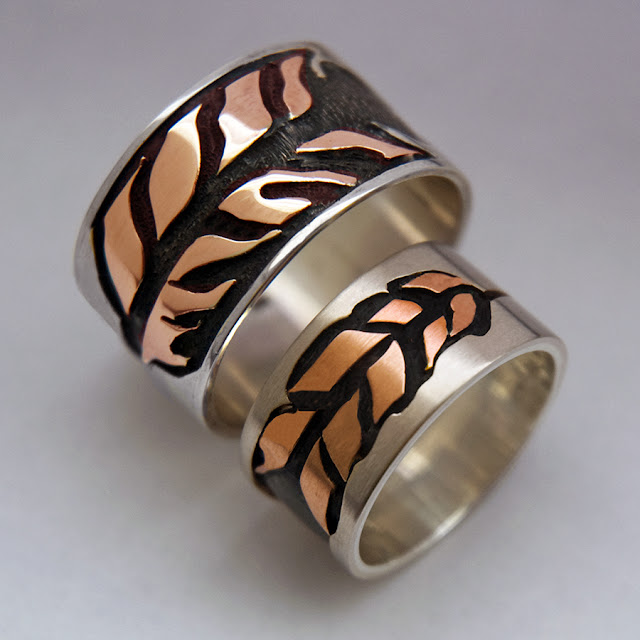 |
| Animikii Ombaashi (“Thunder Takes Flight’’) wedding rings. |
__________________________________________________________
The rings
The ring set, made of sterling silver and 14K gold, is titled Animikii Ombaashi (Thunder Takes Flight). The colorful and contrasting design of an Animikiiwigwan (Thunderbird's feather), depicting Spirit Flight, is dedicated to Animikii Binesiwag, the Thunderbirds.
The inlaid wing feathers of 14 K gold symbolize manidoo (spirit), reminding the
wearers of the rings that eagle feathers, regardless if they are from the bald
eagle or the golden eagle, have the power of the Thunderbirds instilled in
them.
The feathers convey human thoughts and feelings and provide us with the
power and the opportunity to speak directly to the spirit of Animikii Binesi
with debwewin (a
straight mind) and bekide’ewin (a
pure heart)…
__________________________________________________________
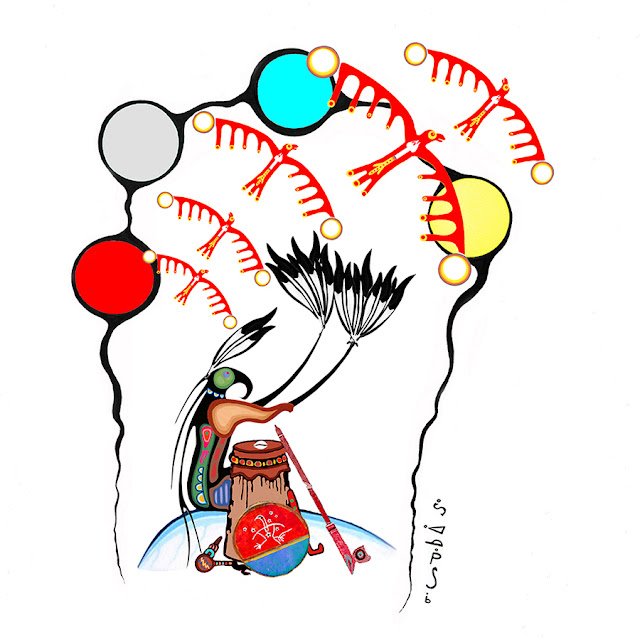
“Spirit Flight,’’ digitized pen and ink on paper by Zhaawano Giizhik ©2022 Zhaawano Giizhik

__________________________________________________________
The drawings
The two colored pen and ink drawings, which I made in the style of the Woodland art painters, reflect the phenomenon of Spirit Flight.
The image of the dancer inside the Sun, titled "Vision Quest," depicts a healer seeking a vision; the vision enables him to fly like an eagle that seeks the deepest blue of the sky - where there is wisdom and curing knowledge to be found. The illustration depicts the healer dancing in the sun, holding two eagle feather fans high - an act that represents great spirit power.
The above "Spirit Flight" illustration, in conclusion, depicts a healer, a Sky Dreamer who sits in isolated fasting and plaintive contemplation on top of a high hill. His face, which shows features of a raptorial bird, is painted green, the color associated with the fertility bringing rain and thunderclouds that the Thunderbirds give to the Earth in springtime. The “X-ray vision’’ cloud designs drawn inside the Sky Dreamer's body also refer to this.
A hand drum can be seen leaning against the water drum, its deerhide membrane featuring red and blue fields divided by a yellow stripe; a white Binesi (Thunderbird) against the background of the asterism called Bagonegiizhig (Hole in the Sky) is superimposed on the red and blue design.This star formation called Pleiades on Western Sky maps, is the spiritual doorway to the Star World.
The design of this type of drum - called Bineshii Dewe’igan or Thunderbird Drum - and certain songs and rituals that go with it are always strictly personal as they are brought to its owner by a Thunderbird Spirit who shows him or her how to make and use it, and the design he or she must paint on it.
The design and colors of the Thunderbird on the hand drum, which represents Manidoo Animikii Bineshi Miikana or Spirit Road of the Thunderbird, depict some of the revitalizing tasks that the Thunder Grandfathers fulfill when they return each spring with the migrating birds, bringing the rain to the earth so that life on earth will continue, like cleansing the earth, the lakes, and the rivers, and sustaining the plants and the trees by giving them water…
it is the sound of these drums, imitating the thunder rolling through the sky, that reminds us that the Thunder Grandfathers represent the linkage between the birds of the sky world and plants of the middle world and underwater creatures, as well as a spiritual connectedness of birds with the physical orders of the cosmos like sun, moon, earth, stars, thunders, lightning, rain, wind, fires, etcetera. The design, colors, and sound of the drum remind the Thunderbird Sky Dreamer that as long as (s)he don’t forget about the Thunder Grandfathers, they will always look after our People.
__________________________________________________________
After beating his Thunderbird hand drum and smoking the opwaagan (pipe) that can seen in the image leaning against the mitigwakik (water drum), during which the stem is turned clockwise through the air for the purpose of asking for merciful treatment, the vision seeker calls on the spirit of obawaagan (his guardian spirit animal), which is Binesi, the Thunderbird. As his mind is in trance his spirit flies high in search of the knowledge and wisdom that he knows lives in the hearts and the visions of the Animikiig (Thunder Grandfathers). The spirit flight is made visible through the five red and yellow Thunderbirds in the image.
The first four Thunderbirds represent all Elders/Teachers/Wisdom Keepers of today, who still walk the earth carrying the biinjigosan/midewayaan (medicine pouch, or bag) of ceremony and knowledge in order to hand it over to the younger generations. They are the generation of the Seventh Fire, which means they propagate walking the road of mino-bimaadiziwin - a long and healthy life of sobriety and mental wellness. The oshkaabewis/little boy water drum in the image, as well as the ceremonial drumstick and the rattle and the sacred pipe that is depicted next to it, represent these important values and lessons safely kept within the sacred space of the Medicine/Teaching/Learning Lodge.
The fifth Thunderbird in the drawing – the one that flies highest - is the one that gwayako-bimaadizi, that walks this straight path of Mino-bimaadiziwin. It symbolizes the spiritual journey-through-life of my friend from Manitoba whose traditional name is Black Eagle. As he walks the straight road seeking Vision, Wisdom, and Knowledge he sits in the Teaching Lodge of his late teacher and tutor but is now ready to fly. All around the Lodge he is soaring. In that way his spirit knows what is ahead. Circling around in the lodge/sky encourages him to look into the future, to spread his wings and fly.
The little white miigis shell sitting on top of the water drum, being a powerful symbol of life and hope, represents my friend, this seeker of vision who sits in the Learning Lodge and who is part of a generation that has lit and now tends the Eight Fire.
As he is in a deep self-reflective state of mind - possibly in trance - , the vision seeker leaves the physical boundaries of the Learning Lodge – here symbolized by the four spirit suns colored yellow, blue, gray, and red. His spirit (symbolized by the fifth Tunderbird) leaves the Lodge and the Earth. Next it breaks through the Ishpiming, the place above us consisting of the atmosphere and the ozon layer, to enter through the Bagonegiizhig (Hole in the Sky) the realms called giizhigong and waakwiing. Still circling, soaring higher and higher, his spirit flies beyond the boundaries of the earth and ishpiming, the air above it. It is his spirit entering giizhigong where the star people live, and beyond, into the realm called waakwi. It is there, in this place of power, where advanced vision, wisdom, and knowledge is to be found. It is the place where the stars are born and where his ancestors and his clan roams, patiently waiting for him to rejoin them when it is time for him to do so.
__________________________________________________________
__________________________________________________________
The fifth Thunderbird in the image, the one who breaks away from the sphere of the dancing orbs, symbolizes my friend and his generation. They are the ones who light the Eight Fire, walk the red road of mino-bimaadiziwin, and spread their wings to leave the nest. The Thunderbird image exemplifies a new generation of Indigenous Awareness that eagerly moves ahead and at the same time patiently and quietly goes back, thoughtfully and respectfully retracing the steps of their ancestors. They are the ones who accept the biinjigosan/midewayaan of vision, wisdom, and knowledge from their Elders and teachers, determined to hand it down to the generations to come.
Haw sa, that fifth Binesi is my friend Black Eagle and his generation. It could also be you, when you go to ceremony and learn wise lessons from the Elders who are still among us. That fifth Binesi, it could be your spirit, always circling, flying high and far, seeking the deepest blue of the sky. And if you fly high enough, you will find yourself bathing in the brilliant light of enlightenment that radiates from the river of Thunderbirds behind the sky; this galactic river of stars and planets, whose banks are lit by the campfires of a long line of ancestors who preceded you...
Nahaaw, miigwech gaa-gii-anamichigeyan o’owe aadizookaan noongom mii dash gidibaajimotoon o'owe bidjaadimowin.
Well, thank you for having read this story today, for allowing me to tell you this story.
__________________________________________________________
About the author and his sources of inspiration:
 |
As an American artist and jewelry designer currently living in the Netherlands, I like to draw on the oral and pictorial traditions of my Ojibwe Anishinaabe ancestors from the American Great Lakes area. For this I call on my manidoo-minjimandamowin, or "Spirit Memory"; which means I try to remember the knowledge and the lessons of my ancestors.
The mazinaajimowinan or ‘‘pictorial spirit writings’’ - which are rich with symbolism and have been painted throughout history on rocks and etched on other sacred items such as copper and slate, birch bark and animal hide - were a form of spiritual as well as educational communication that gave structure and meaning to the cosmos.
Many of these sacred pictographs or petroforms – some of which are many, many generations old - hide in sacred locations where the manidoog (spirits) reside, particularly in those mystic places near the coastline where the sky, the earth, the water, the underground and the underwater meet. It is these age-old expressions that provide an endless supply of story elements to my work; be it graphically, through my written stories, as well as in the context of my jewelry making.
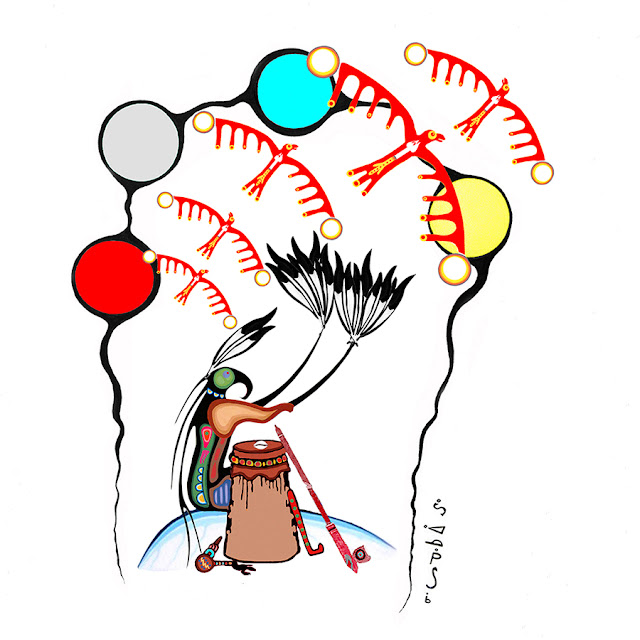



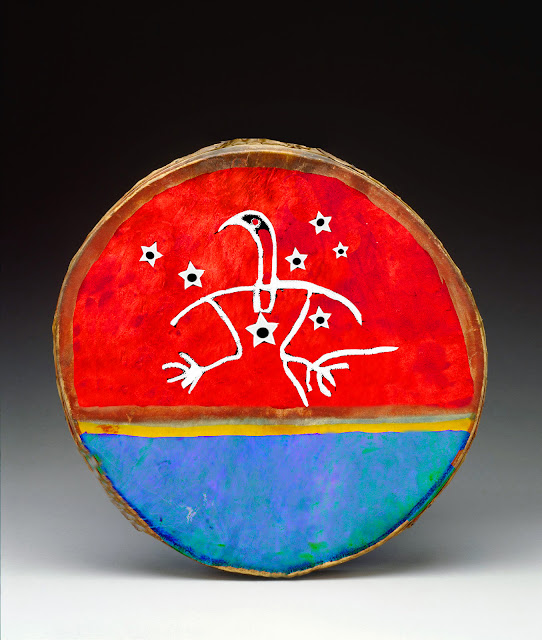

No comments:
Post a Comment